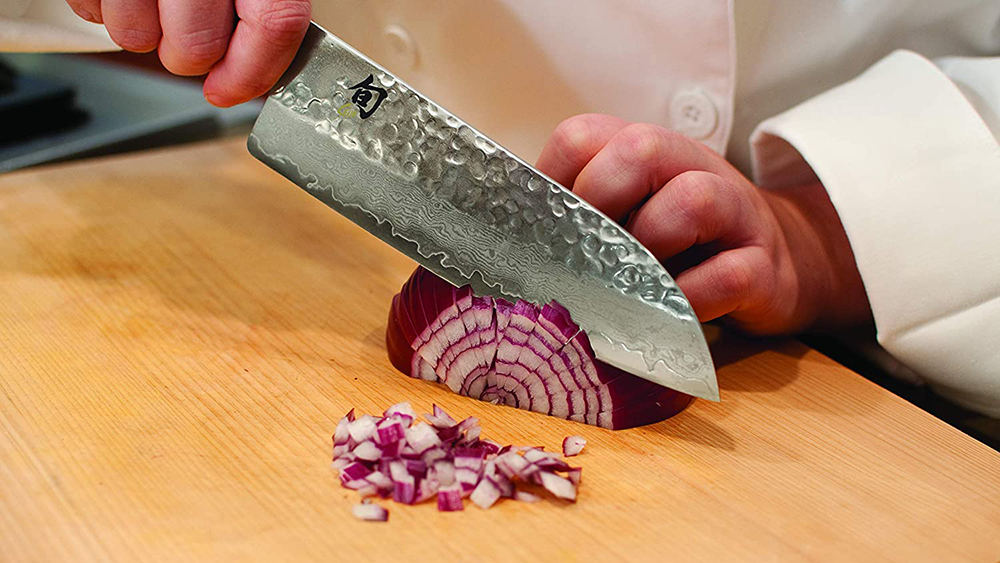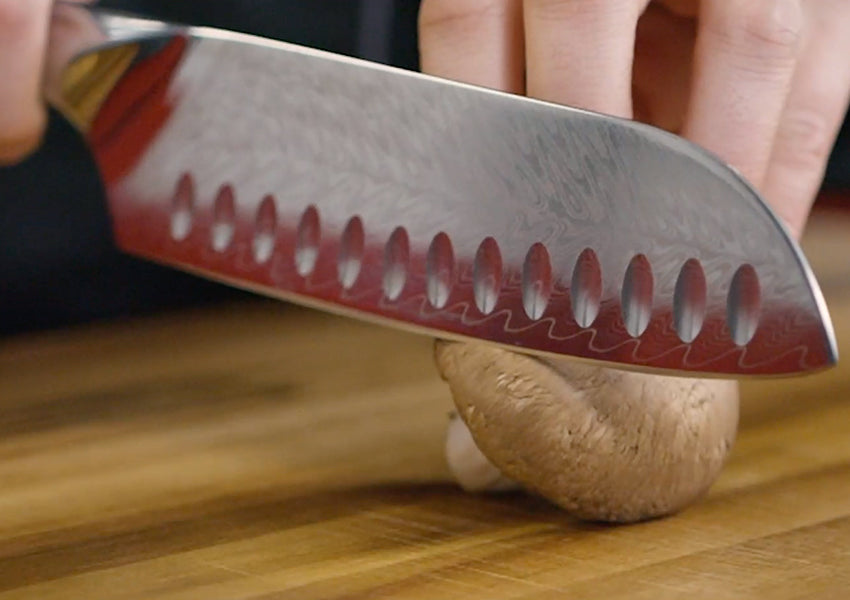Do you love to cook? Or do you just find pleasure watching Chefs when cutting or slicing your food in a restaurant? In these modern times, different cuisines are upsurging that surprises our palates. And one thing that amazes food lovers, like you, is the way they prepare your food. If you are wondering how Chefs present your meal in an excellent cut, their knives are the ones responsible for it. As we all know, the knife is for cutting. But there is more behind that definition. Like the famous Japanese knife, Santoku. It is the secret of most Chefs for specialized cuts.
In this exceptional blog, we will reveal how to use the Santoku knife and its difference from other types of knives. So keep on reading and share your cooking experience in the comment section at the end of this blog. Enjoy!
What Is Santoku Knife?

One thing to remember on how to become great at knife skills is to know the origin of your knife. Santoku is part of the culture, and you must understand how it is made and where it came from.
🔪 Origin
The Santoku knife is an old Asian knife, primarily Japanese. It is like a Chef’s knife and related to Gyuto with a broader blade, but it’s more of a chopper instead of rocking. So the word Santoku means “three virtues,” which indicates that you can use it to cut meat, vegetables, or fish. The Japanese formed the Santoku based on the western Chef’s knife, but they altered the knife profile to be straighter to adapt to the Japanese style of chopping.
🔪 Description
The Santoku knife is also reasonably short, with a length of around 7 to 6 inches. It has a very slight curve, and the tip curves down to it. That way, when you use the Santoku knife, you just use it in more of an up-and-down motion or a cutting forward motion. The Santoku knife is also high carbon steel, so you must keep it dry and clean because it will rust quickly.
🔪 Profile
Most Santoku sold now are all hybrid Santoku’s. This means that there is a gentle front curve to accommodate the rocking motion. But, the heel part is primarily flat with a slight upward rounded curve so that there is no hard stop while rocking. The traditional profile is rarely sold now. That is why hybrids were created. Both profiles accommodate the forward chopping motion, while the hybrid suits the western cuisine better.
Since the Santoku is an adaptation of the western Chef’s knife, it should have a distal spine taper. This makes the knife lighter, provides better comfort while gripping, gives you more surface to push down, and gives you a sharper performance for tougher food.
Things To Consider Before Using Santoku Knife

In order to know if the Santoku knife is for you, you must know the points on how to identify it.
🔪 Types of cook
If you are a person that loves to rock, then the western Chef’s knife is a better choice. But for most home cooks, the rocking motion does not come naturally and requires practice. If you are a person that uses a forward chopping motion, then the Santok is for you.
🔪 Length of the knife
The other strong point is because of its shorter length. It is a lot easier to get control over the knife. You will be more precise with your cuts compared to a long knife. Another thing is that it keeps the ability to rock, but since the profile is less curved, it is excellent for rocking herbs that have less stack height.
🔪 Downside
Keep in mind that the downside is the length, and you need to prepare food in sections to accommodate the knife length. Therefore, it is a knife that many professional cooks don’t like to use. This knife is also great for home use when you only need to prepare a meal for four persons instead of 40. Another thing that degrades the name of Santoku is its piercing power. If you love to cook, you also love when you open food packaging by using a knife. But if you use Santoku, you’ll miss this option.
🔪 Handle
There are also many handle choices when it comes to Santoku, significantly since the popularity of the Santoku in the West is rising. Knife handles like the wooden octagonal or oval-shaped handles are all considered traditional handles. They all have a partial tang which is regarded as less durable than a full tang handle since the blade is glued into the handle. The only reason for going for a traditional handle is aesthetic and history.
The Western handle is more studier and more impact resistant than a glued handle. And because of the forward chopping, there is naturally more impact on the knife in general, so the recommended choice is the full tang western handle when it comes to Santokus.
🔪 Grip
When talking about the gripping style, it is advisable to use the pinch grip. Also, a forward chopping style is not recommended with a fingertip grip since this will strain your fingers. The grip is only recommended for slicing motions, and you will usually only dee these gripping styles on sushi chefs.
The Santoku knife has changed over the years, and now it is an excellent fusion between western and Japanese cuisine.
Functions Of Japanese Knife
When it comes to Japanese knives, you have a lot of different variations of functions and aesthetics. The hammered finish helps with food release but is only noticeable when the food actually reaches the hammered part. Most Japanese knives also come with cladding. They have added that to reinforce the knives and to prevent them from breaking.
There are also Japanese knives that are not fully polished and are purely for aesthetics. These are usually a lot cheaper and may get scratches in no time. One thing to note is that fruit is very expensive in Japan, and if you use Kuroichi that Santoku, it will react on acidic fruits like lemons and therefore not suitable for it.
When To Use Santoku Knife?

As mentioned above, the Santoku knife is best used for dicing, chopping, and mincing. To be specific, you can use this knife when slicing cheese, mincing herbs, cutting meat, and fine cuts for vegetables and seafood. Because of its versatility, it is best used for celery, carrots, or broccoli. As you can see, you can use Santoku in different food, but you must take note that you need to learn the proper grip and strength before holding the knife. This is because you can damage the Santoku, especially if you bought the hybrid type.
Bottom Line
This sort of knife allows meal preparation as fast and pleasant as possible thanks to its outstanding durability and its blade that is well appropriate to a rocking cut. If you’re considering acquiring a Santoku, you’re in the right mind since it’s a fantastic knife that comes with a lifetime guarantee. There are a lot of wonderful models out there, so ask your friends to see who has the most incredible knife in their collection. Whatever you wish to chop, the santoku knife is a versatile piece of cooking necessity that will come in handy in any kitchen.
If you already have lots of knives in your kitchen but do not know where to place them, you can refer HERE to learn how to organize your kitchen.
